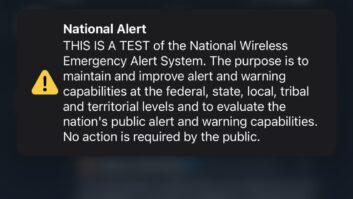
SACRAMENTO, Calif. — When I think of JK Audio’s RemoteMix line of products, I think of useful tools in small packages. Continuing with this ideal, JK Audio has put forth the RemoteMix 2, their newest two-channel field mixer, in the familiar RemoteMix package and style. It is like the little brother of the RemoteMix 3.5 and 4 products.
The RemoteMix 2 maintains many features of its elder brethren — XLR microphone inputs with the second channel providing a switchable microphone to line-level pad, 1/4-inch TRS headphone outputs, 1/4-inch TRS/TRRS shared cue/cellular interface, 1/8-inch line input and line outputs and a nice LED vu meter — but it also maintains the analog POTS hybrid and a handy dual 9V battery compartment that allows for hot-swapping your batteries during extended use.
In order to fit all of this into a package that is two inches narrower, 1.5 inches shallower and a little more than 0.5 inches shorter than the RemoteMix 3.5 and 4, some features of these products do not exist in the RemoteMix 2. The company has removed Bluetooth and the handset accessory interface, as well as the 48V phantom power supplies. It maintains the cue volume input control, but it trades the master volume output for an auxiliary input volume control.
In practical terms, it’s still a very useful device, but some missing features may limit its utility. For many of our live remotes, we came to really enjoy the handset accessory interface, as cellular service can be spotty and a POTS line is not always available. The ability to interconnect through a PBX or VoIP handset saved the day on many occasion, even when we had an IP codec available. The handset interface was an excellent method for calling into our hybrid located at the studio and providing a low-delay IFB or caller audio path for mixing at the remote location, or for covering during the inevitable codec dropout.
We received a pre-production demonstration unit from JK Audio early June and after the standard unboxing and bench tests, we wanted to see how this mixer measured up to its bigger brothers in the field.
Luckily, we found the perfect opportunity at a concert we were covering. The situation required delivering remote audio by using a laptop with a USB audio interface at the remote site to edit the audio and then upload it to the studios. For this remote, the onsite crew wanted to add a second microphone for interviews as well as a line-level input for capturing the audio from the stage.
In this setup we connected the microphones directly to the XLR microphone connectors, and the talent headphones were connected to the first headphone port. To feed the computer audio back to the talent, we used the included 1/8-inch-to-1/4-inch cable and connected that through the cue input connector. Finally, for the stage feed, we were provided a 1/4-inch stereo line and connected that to the auxiliary input through a 1/4-inch- to-1/8-inch adapter.
For this duty, the RemoteMix 2 was an excellent solution. Setup and staff training were quick and easy, and we were able to leave the device in their hands and on battery power for the entirety of the six-hour remote without incident.
In the end, even though it lacks some high-end features of the RemoteMix 3.5 and 4 products, it’s every bit as rugged and easy to use, and the sound quality is still excellent.
For information, contact JK Audio in Illinois at (815) 786-2929 or visitwww.jkaudio.com.












